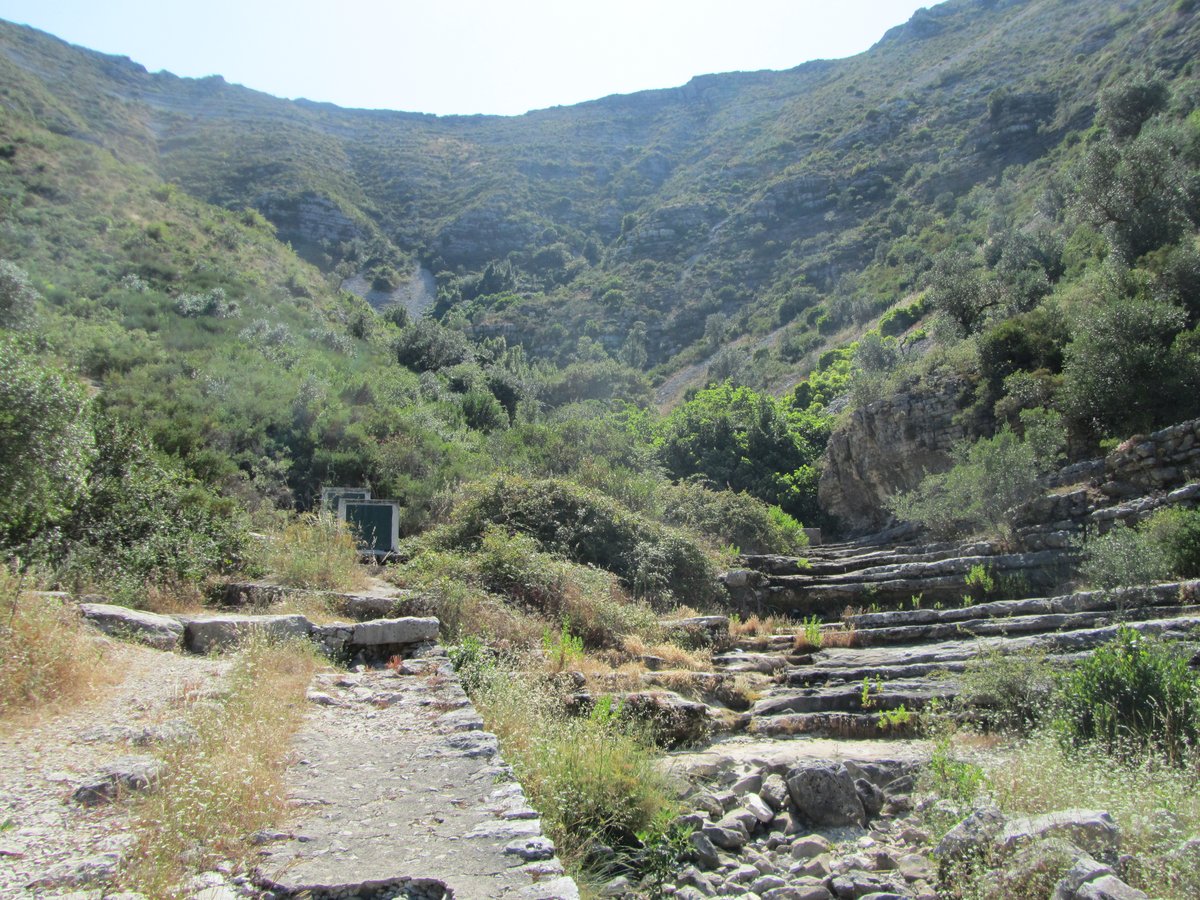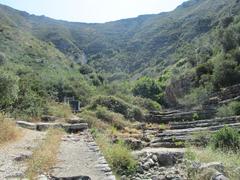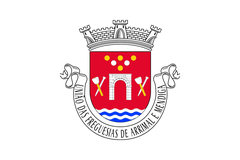
Visiting Hours, Tickets, and Historical Sites of Nascente da Ribeira da Fórnea, Amiais de Baixo, Portugal
Date: 24/07/2024
Introduction
Nestled in the picturesque landscape of Amiais de Baixo, Portugal, the Nascente da Ribeira da Fórnea is a natural spring rich in history and cultural significance. The village of Amiais de Baixo, where this spring is located, dates back to the 15th century and has evolved from a community of woodcutters and brickmakers to a diversified economy (ESCS Magazine). The spring itself is part of a larger hydrological system that includes the Alviela River, known for its essential contribution to the Lisbon metropolitan area’s water supply (Wikiloc). Visitors are drawn to this site not only for its natural beauty but also for its historical and cultural richness, making it a must-visit destination for history buffs, nature enthusiasts, and travelers alike.
Table of Contents
- [Historical Background](#historical-backgroundhistorical-background-of-nascente-da-ribeira-da-fórnea-amiais-de-baixo-portugal)
- [Origins and Early History](#origins-and-early-historyorigins-and-early-history)
- [Economic Development](#economic-developmenteconomic-development)
- [Cultural and Social Dynamics](#cultural-and-social-dynamicscultural-and-social-dynamics)
- [Architectural Heritage](#architectural-heritagearchitectural-heritage)
- [Natural and Geographical Significance](#natural-and-geographical-significancenatural-and-geographical-significance)
- [The Nascente da Ribeira da Fórnea](#the-nascente-da-ribeira-da-fórneathe-nascente-da-ribeira-da-fórnea)
- [Modern Developments](#modern-developmentsmodern-developments)
- [Visitor Tips](#visitor-tipsvisitor-tips)
- [Visitor Information](#visitor-informationvisitor-information)
- [Exploring Nascente da Ribeira da Fórnea](#exploring-nascente-da-ribeira-da-fórneaexploring-nascente-da-ribeira-da-fórnea)
- [Introduction](#introductionintroduction)
- [Historical Context](#historical-contexthistorical-context)
- [Geological Importance](#geological-importancegeological-importance)
- [Biodiversity and Environmental Significance](#biodiversity-and-environmental-significancebiodiversity-and-environmental-significance)
- [Cultural and Social Significance](#cultural-and-social-significancecultural-and-social-significance)
- [Tourism and Recreational Activities](#tourism-and-recreational-activitiestourism-and-recreational-activities)
- [Visitor Tips](#visitor-tipsvisitor-tips-1)
- [Accessibility](#accessibilityaccessibility)
- [Conservation Efforts](#conservation-effortsconservation-efforts)
- [Educational Opportunities](#educational-opportunitieseducational-opportunities)
- [Local Legends and Folklore](#local-legends-and-folklorelocal-legends-and-folklore)
- [Photography and Art](#photography-and-artphotography-and-art)
- [Future Prospects](#future-prospectsfuture-prospects)
- [Frequently Asked Questions](#frequently-asked-questionsfrequently-asked-questions)
- [Call to Action](#call-to-actioncall-to-action)
Historical Background of Nascente da Ribeira da Fórnea, Amiais de Baixo, Portugal
Origins and Early History
The village of Amiais de Baixo, where the Nascente da Ribeira da Fórnea is located, dates back to the 15th century. The name “Amiais” is believed to derive from the abundance of alder trees (amieiros) along the banks of the Ribeira de Amiais, a significant fluvio-karstic phenomenon in Portugal (ESCS Magazine). The suffix “de Baixo” was added to distinguish it from the nearby settlement of Amiais de Cima, which belongs to the parish of Abrã (Wikipedia).
Economic Development
Historically, Amiais de Baixo was a community of woodcutters, lumberjacks, sawyers, and small forest owners. These men often left their homes for extended periods, leaving their wives and children behind. The village’s economy was further bolstered by the establishment of brick factories, which gave it an industrial character (ESCS Magazine). Over time, the village adapted to changing economic conditions, shifting from wood extraction and brick manufacturing to industries such as ceramics, electronics, and furniture (Wikipedia).
Cultural and Social Dynamics
The people of Amiais de Baixo are known for their intelligence, activity, and resourcefulness. This community spirit is reflected in the village’s vibrant social life and numerous events. The most notable of these is the annual festival in honor of Martyr São Sebastião, which has been celebrated for over 150 years (Amiribatejo).
Architectural Heritage
Amiais de Baixo has a limited number of historical or architectural landmarks. The most significant is the Igreja Matriz de Nossa Senhora da Graça, built after 1852. Before the establishment of the parish, a small chapel dedicated to São Gens existed in the 17th century (Wikipedia).
Natural and Geographical Significance
The village is situated in a valley south of the Porto de Mós Massif, with the Serra dos Candeeiros to the west and the Serra de Aire to the north. This location provides a stunning natural backdrop, making it a popular destination for outdoor activities such as hiking and mountain biking (Komoot).
The Nascente da Ribeira da Fórnea
The Nascente da Ribeira da Fórnea is a notable natural feature in the region. It is part of the larger hydrological system that includes the Alviela River, which originates from the Olhos de Água springs. These springs are among the most important in Portugal, providing water to the Lisbon metropolitan area (Wikiloc).
Modern Developments
In recent years, Amiais de Baixo has continued to evolve, with a focus on diversifying its economic base. The village now hosts around 51 registered businesses, including those in the wood, electronics, and service industries (Amiribatejo). This entrepreneurial spirit is a testament to the resilience and adaptability of its inhabitants.
Visitor Tips
For those planning to visit the Nascente da Ribeira da Fórnea, it is advisable to explore the surrounding trails and natural attractions. The area offers numerous hiking routes, such as the PR1 and PR8 trails, which provide insights into the region’s geological and hydrological features (Wikiloc). Additionally, the nearby Praia Fluvial dos Olhos d’Água do Alviela offers a refreshing spot for swimming and relaxation.
Visitor Information
- Visiting Hours: The Nascente da Ribeira da Fórnea is open to visitors year-round. However, it is best visited during daylight hours to fully appreciate its natural beauty.
- Tickets: Entry to the Nascente da Ribeira da Fórnea is free. Some surrounding attractions may have associated costs, so it’s advisable to check ahead.
- Guided Tours: While there are no official guided tours, local guides can be arranged through the visitor center in Amiais de Baixo.
- Travel Tips: Wear comfortable walking shoes and bring water, especially if you plan to hike the trails. A camera is recommended to capture the picturesque landscapes.
- Nearby Attractions: Don’t miss the Praia Fluvial dos Olhos d’Água do Alviela for a refreshing swim and the Igreja Matriz de Nossa Senhora da Graça for a touch of local history.
Exploring Nascente da Ribeira da Fórnea
Introduction
Nestled in the picturesque landscape of Amiais de Baixo, Portugal, the Nascente da Ribeira da Fórnea is a natural spring rich in history and cultural significance. This guide provides everything you need to know, from its historical context and geological importance to visitor tips and nearby attractions. Whether you’re a history buff, a nature enthusiast, or planning your next travel adventure, read on to discover why the Nascente da Ribeira da Fórnea is a must-visit destination.
Historical Context
The Nascente da Ribeira da Fórnea, located in Amiais de Baixo, Portugal, is a natural spring that has been a vital water source for the region for centuries. The area surrounding the spring has a rich history, dating back to ancient times when local communities relied on it for their daily water needs. The spring’s significance is not only practical but also cultural, as it has been a focal point for local folklore and traditions.
Geological Importance
The Nascente da Ribeira da Fórnea is situated in the Serra de Aire e Candeeiros Natural Park, a region known for its unique karst landscape. The spring is part of a larger hydrogeological system that includes underground rivers and caves. The water from the spring is exceptionally pure, filtered through the limestone rock formations that characterize the area. This geological setting makes the spring a point of interest for geologists and hydrologists studying karst systems and groundwater flow.
Biodiversity and Environmental Significance
The area around the Nascente da Ribeira da Fórnea is home to a diverse range of flora and fauna. The spring and its surrounding wetlands provide a habitat for various species of plants, birds, and aquatic life. The presence of endemic species and the overall biodiversity make it a critical area for conservation efforts. The spring’s water quality is also a key indicator of the health of the local ecosystem, making it an important site for environmental monitoring.
Cultural and Social Significance
The Nascente da Ribeira da Fórnea holds a special place in the hearts of the local community. It has been a gathering spot for generations, where people come to collect water, socialize, and celebrate local festivals. The spring is often featured in local legends and stories, adding to its cultural richness. Events such as the annual water festival highlight the community’s connection to this natural resource.
Tourism and Recreational Activities
The Nascente da Ribeira da Fórnea is a popular destination for tourists and outdoor enthusiasts. The area offers a range of activities, including hiking, bird-watching, and picnicking. The scenic beauty of the spring and its surroundings make it a perfect spot for photography and nature walks. Guided tours are available, providing visitors with insights into the spring’s history, geology, and ecological importance.
Visitor Tips
- Best Time to Visit: The spring is accessible year-round, but the best time to visit is during the spring and autumn months when the weather is mild, and the landscape is lush.
- What to Bring: Comfortable walking shoes, a camera, and a water bottle are essential. If you plan to hike, bring a map and a compass or GPS device.
- Respect the Environment: As a protected area, it is crucial to follow the Leave No Trace principles. Do not litter, disturb wildlife, or damage plants.
- Local Amenities: There are several small cafes and restaurants in Amiais de Baixo where you can enjoy local cuisine. Public restrooms are available near the main entrance to the spring.
Accessibility
The Nascente da Ribeira da Fórnea is relatively easy to access. It is located about 100 kilometers north of Lisbon, and the drive takes approximately 1.5 hours. There is a parking area near the entrance, and the path to the spring is well-marked and suitable for all fitness levels. For those relying on public transportation, buses run regularly from Lisbon to Amiais de Baixo.
Conservation Efforts
The local government and environmental organizations are actively involved in the conservation of the Nascente da Ribeira da Fórnea. Efforts include monitoring water quality, protecting native species, and promoting sustainable tourism practices. Visitors are encouraged to support these efforts by adhering to guidelines and participating in conservation activities when possible.
Educational Opportunities
The Nascente da Ribeira da Fórnea offers numerous educational opportunities for students and researchers. Schools often organize field trips to the spring, where students can learn about geology, hydrology, and ecology. Researchers from universities and environmental organizations frequently conduct studies in the area, contributing to the broader understanding of karst systems and groundwater resources.
Local Legends and Folklore
The spring is steeped in local legends and folklore. One popular story tells of a hidden treasure buried near the spring, guarded by mythical creatures. Another legend speaks of the healing properties of the spring’s water, believed to cure various ailments. These stories add a layer of mystique to the site, attracting visitors interested in local culture and history.
Photography and Art
The natural beauty of the Nascente da Ribeira da Fórnea has inspired many photographers and artists. The interplay of light and water, the lush greenery, and the rugged rock formations provide endless opportunities for creative expression. Local art galleries often feature works inspired by the spring, and photography workshops are occasionally held in the area.
Future Prospects
The future of the Nascente da Ribeira da Fórnea looks promising, with ongoing efforts to enhance its accessibility and preserve its natural beauty. Plans include the development of more educational programs, improved visitor facilities, and expanded conservation initiatives. The spring will continue to be a vital resource for the local community and a cherished destination for visitors from around the world.
For more information, you can visit the official Serra de Aire e Candeeiros Natural Park website.
Frequently Asked Questions
- What are the visiting hours for Nascente da Ribeira da Fórnea? The spring is accessible year-round, but specific visiting hours can vary. It’s best to check the official Serra de Aire e Candeeiros Natural Park website for the most up-to-date information.
- Is there an entrance fee or tickets required to visit Nascente da Ribeira da Fórnea? There is no entrance fee to visit the spring, making it an affordable destination for all visitors.
- What are some nearby attractions in Amiais de Baixo? In addition to the Nascente da Ribeira da Fórnea, visitors can explore other historical sites in Amiais de Baixo, such as local churches and traditional Portuguese architecture.
- Are guided tours available? Yes, guided tours are available and provide valuable insights into the spring’s history, geology, and ecological importance.
Call to Action
Download the Audiala mobile app to stay updated on the latest events and activities at the Nascente da Ribeira da Fórnea. Follow us on social media for more travel tips and information on other must-visit destinations. Don’t forget to check out our other related posts for more travel inspiration.
Conclusion
The Nascente da Ribeira da Fórnea in Amiais de Baixo is a compelling destination that offers a unique blend of natural beauty, historical depth, and cultural richness. From its origins in the 15th century to its modern-day significance, this natural spring has been a vital part of the local community. The surrounding trails, geological features, and biodiversity make it an ideal spot for outdoor activities and educational opportunities. The village’s evolving economy and vibrant social life further enhance the visitor experience, making Amiais de Baixo a noteworthy destination in Portugal (Amiribatejo). Whether you’re interested in exploring the fluvio-karstic landscapes, participating in local festivals, or simply enjoying the serene environment, Nascente da Ribeira da Fórnea offers something for everyone.
References
- ESCS Magazine. Amiais de Baixo: Uma Vila no Coração do Ribatejo. https://escsmagazine.escs.ipl.pt/amiais-de-baixo-uma-vila-no-coracao-do-ribatejo/
- Wikipedia. Amiais de Baixo. https://pt.wikipedia.org/wiki/Amiais_de_Baixo
- Amiribatejo. Amiais de Baixo: Uma Vila Cheia de Tradições. https://amiribatejo.pt/amiais-de-baixo-uma-vila-cheia-de-tradicoes/
- Komoot. Attractions Around Amiais de Baixo. https://www.komoot.com/guide/2532824/attractions-around-amiais-de-baixo
- Wikiloc. Hiking Trails in Amiais de Baixo. https://www.wikiloc.com/trails/hiking/portugal/santarem/amiaes-de-baixo

